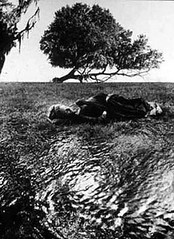Art of
Arrangement: Photography and the Still Life Tradition
11 February to 7 May
2012
This exhibition explores the use of objects within a Still
Life and how Artists and Photographers have experimented with techniques and
ideas over many years. It holds the works of Artists/Photographers, such as
Ansel Adams, Edward Western, Dorothea Lange, Paul Strand and many more masters
of the Art world.
It was fascinating to see such rare and one-of-a-kind prints
in one room and to have this opportunity that might not come again.
I have chosen particular pieces of work from each section of
the exhibition which will be underlined and these were the ones that I drew my
attention to aesthetically and technically. However the images were not allowed
to be photographed close-up and some are not found online either, obviously for
issues of preservation etc..
View of the Gallery
On Close Inspection
William
Henry James Coombs, Negative radiograph of Tulip
(Gelatin
Silver) Unfortunately no image.
A radiograph is an image produced on a
radiosensitive surface, such as a photographic film, by radiation other than
visible light, especially by x-rays passed through an object or by
photographing a fluoroscopic image. Also called shadowgraph, skiagram, skiagraph.
For example:
Floral radio-graph, produced by Albert Richards
Arrangments in negatives
The grouping and
positioning of different parts of a photograph.
The images displayed are very unique in style and demonstrate technical ability and creativity and are very artistic. Now knowing how these images were produced makes you aware of the skill and time put into each one.
Henry Peach Robinson,
Fading Away, 1858
(Used several negatives to
produce one photograph)
Still Life in a camera
The passing of time,
fleeting nature of life, particular arrangements, carefully positioned
equipment, framing and cropping.
The work is quite abstract and relates more to "Art" photography compositionally and aesthetically because of the way it's constructed. You are given the opportunity to explore the image further into detail by cropping from a much varied image.
Edward Western, Detail of
Abandoned Car, Mojave Desert, New Mexico, 1937
Ansel Adams, Moth and Stump,
Interglacial forests, Glacier Bay, National Monument, 1949
Reflection on light and dark
Photography and light
Natural and
This work is quite experimental in terms of lighting and it's interesting to see how one interprets different settings and objects with different ways of light. Light can illuminate, highlight, accentuate or alienate a subject depending on the situation and the artists' intentions.
Paul Strand, Photograph-New
York, 1916
Order and Disorder
Objects carefully selected
and ordered to create a visually pleasing or meaningful image.
This sort of work makes you wonder whether you could call it "staged" photography or unrealistic, however I feel if you use the objects that belong to that particular space you are not manipulating the scene or reality in any way as there hasn't really been any interference.
James Jarche, George Bernard
Shaw's work table, 1939
Ian Beesley, Pieces,
Drummond's Mill, Bradford 1986
Dorothea Lange, Corner of
the Dazey Kitchen, 1939
Still life with the figure
Human figure is not the
primary focus, important part of wider arrangement
Illustrates personality or
artistic practise, or symbolic, meaningful things.
These images are very beautiful and the artist's have been very subtle in their approach to using the figure within their work. In some of the photographs there are only hints of a person whereas others have a face of the body, representing or meaning something as part of the image.
Chris Killip, Royal Wedding
table, 1981
Horst P Horst, Gloves, New
York, 1947

Julia Margaret Cameron, The
Return After 3 Days
The Subversive
Records events, mortality, passing of time, political or personal messages.
Jo Spence, Still Life, 1985
Spence documented her body ans surroundings during her treatment of cancer, it was a sense of self which she then coined the term, "photo-therapy". Her work is very inspirational and political and sends messages to everyone who may have gone through similar experiences as herself.
Karen Knorr, A young nobleman's introduction to knowledge, 1984
This work was specifically about country life and the British class system.
A Dialogue with painting
"Vanitas"
These paintings contain a moral or religious message, a shortness of life and inevitability of decline and death. They also contain long exposures of time with the still life being ideal to represent this.
Roger Fenton, Still Life with parian vase, Grapes and silver cup, 1860
The painter is mirrored in the goblet, were these his intentions, or just a happy accident?
Movement and Stillness
They freeze a moment in time, stop and reflect and show action.
Harold Edgerton, Bullet through a jack of diamond, 1955
Philippe Halsman, Dali Atomicus, 1948
The iconic image of Salvador Dali is questioned by many at how this piece was constructed and seeing it for the first time allowed us the answer to just this.
The objects were suspended by thread, with the help from an assistant that held the chair and everything else thrown into the air, all very spontaneous. The whole production took 6 hours with 28 throws. The final image was the only successful one out them all.
The Holburne Museum in the City of Bath and the exhibition, "Art of arrangement", is definitely worth going for.










No comments:
Post a Comment